Leadership Styles: Paternalistic vs. Participative Approaches Analyzed
VerifiedAdded on 2023/06/09
|8
|2156
|270
Essay
AI Summary
This essay provides an in-depth analysis of leadership styles in two distinct contexts: multinational firms and construction sites. The essay begins by examining the paternalistic leadership style often adopted by CEOs of multinational firms, highlighting its potential to foster employee loyalty and high performance. It explores the role of the CEO in making critical corporate decisions, managing resources, and acting as a communication bridge within the organization. The analysis emphasizes how paternalistic leaders can create a supportive environment, encourage employee creativity, and improve overall productivity. In contrast, the essay then delves into the participative leadership style employed by supervisors in construction sites. This style emphasizes the importance of incorporating employee input in decision-making processes, fostering collaboration, and adapting work conditions based on employee feedback. The essay explores the benefits of this approach in terms of employee motivation and the collaborative nature of construction tasks. It concludes by underscoring the significance of adopting appropriate leadership styles to effectively manage diverse organizational environments.

Running head: LEADERSHIP
Leadership
Name of the Student
Name of the University
Author note
Leadership
Name of the Student
Name of the University
Author note
Paraphrase This Document
Need a fresh take? Get an instant paraphrase of this document with our AI Paraphraser
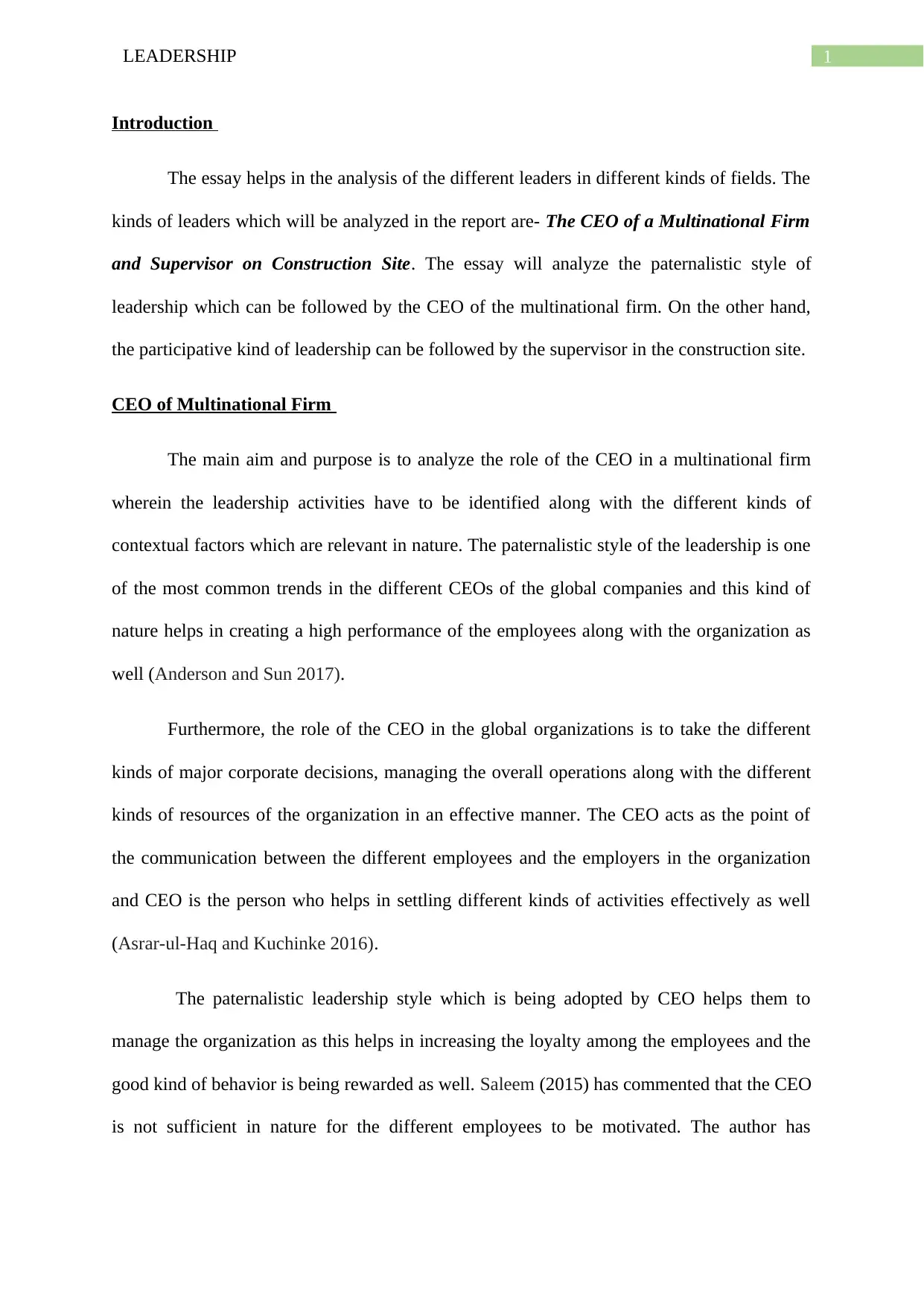
1LEADERSHIP
Introduction
The essay helps in the analysis of the different leaders in different kinds of fields. The
kinds of leaders which will be analyzed in the report are- The CEO of a Multinational Firm
and Supervisor on Construction Site. The essay will analyze the paternalistic style of
leadership which can be followed by the CEO of the multinational firm. On the other hand,
the participative kind of leadership can be followed by the supervisor in the construction site.
CEO of Multinational Firm
The main aim and purpose is to analyze the role of the CEO in a multinational firm
wherein the leadership activities have to be identified along with the different kinds of
contextual factors which are relevant in nature. The paternalistic style of the leadership is one
of the most common trends in the different CEOs of the global companies and this kind of
nature helps in creating a high performance of the employees along with the organization as
well (Anderson and Sun 2017).
Furthermore, the role of the CEO in the global organizations is to take the different
kinds of major corporate decisions, managing the overall operations along with the different
kinds of resources of the organization in an effective manner. The CEO acts as the point of
the communication between the different employees and the employers in the organization
and CEO is the person who helps in settling different kinds of activities effectively as well
(Asrar-ul-Haq and Kuchinke 2016).
The paternalistic leadership style which is being adopted by CEO helps them to
manage the organization as this helps in increasing the loyalty among the employees and the
good kind of behavior is being rewarded as well. Saleem (2015) has commented that the CEO
is not sufficient in nature for the different employees to be motivated. The author has
Introduction
The essay helps in the analysis of the different leaders in different kinds of fields. The
kinds of leaders which will be analyzed in the report are- The CEO of a Multinational Firm
and Supervisor on Construction Site. The essay will analyze the paternalistic style of
leadership which can be followed by the CEO of the multinational firm. On the other hand,
the participative kind of leadership can be followed by the supervisor in the construction site.
CEO of Multinational Firm
The main aim and purpose is to analyze the role of the CEO in a multinational firm
wherein the leadership activities have to be identified along with the different kinds of
contextual factors which are relevant in nature. The paternalistic style of the leadership is one
of the most common trends in the different CEOs of the global companies and this kind of
nature helps in creating a high performance of the employees along with the organization as
well (Anderson and Sun 2017).
Furthermore, the role of the CEO in the global organizations is to take the different
kinds of major corporate decisions, managing the overall operations along with the different
kinds of resources of the organization in an effective manner. The CEO acts as the point of
the communication between the different employees and the employers in the organization
and CEO is the person who helps in settling different kinds of activities effectively as well
(Asrar-ul-Haq and Kuchinke 2016).
The paternalistic leadership style which is being adopted by CEO helps them to
manage the organization as this helps in increasing the loyalty among the employees and the
good kind of behavior is being rewarded as well. Saleem (2015) has commented that the CEO
is not sufficient in nature for the different employees to be motivated. The author has
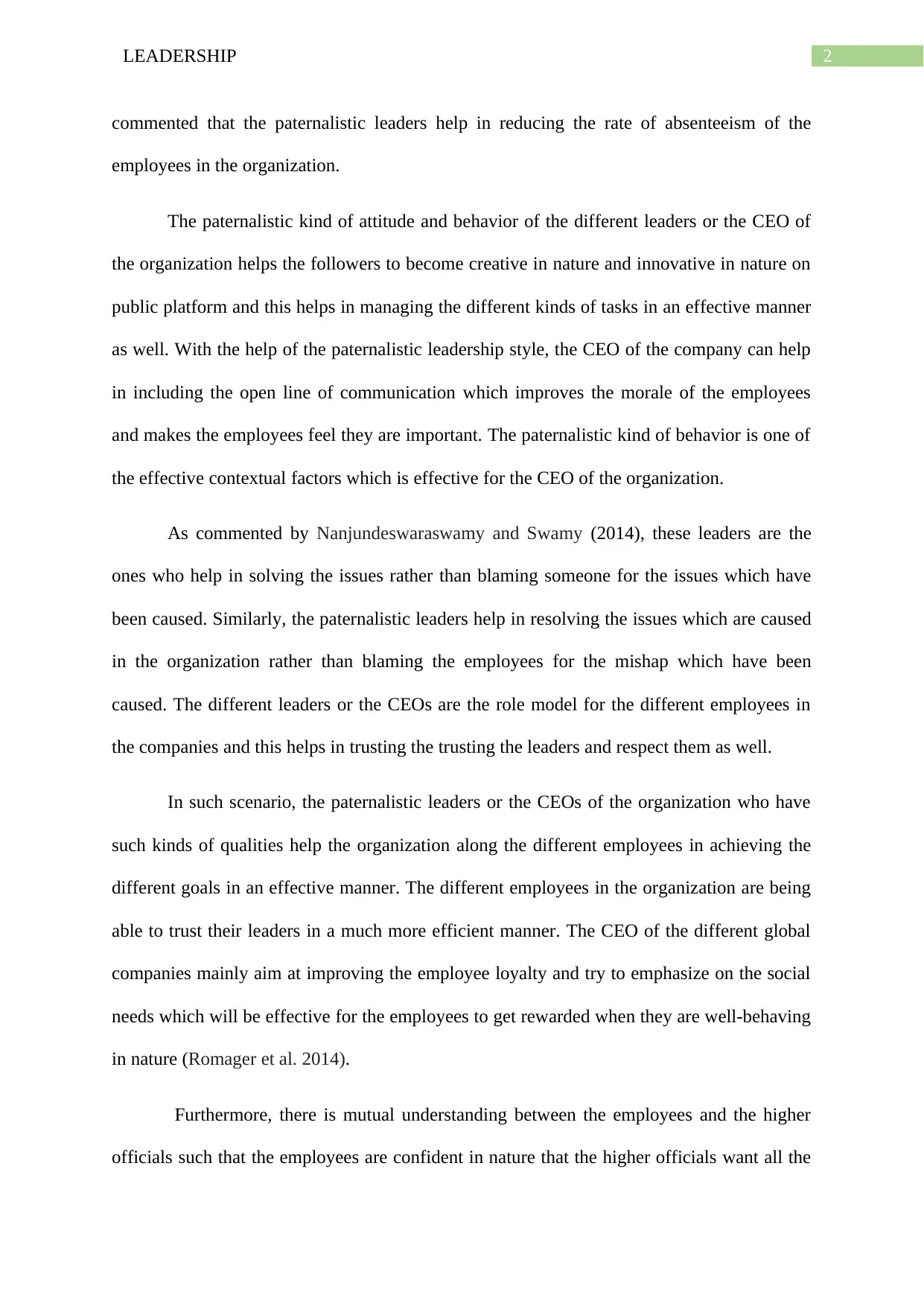
2LEADERSHIP
commented that the paternalistic leaders help in reducing the rate of absenteeism of the
employees in the organization.
The paternalistic kind of attitude and behavior of the different leaders or the CEO of
the organization helps the followers to become creative in nature and innovative in nature on
public platform and this helps in managing the different kinds of tasks in an effective manner
as well. With the help of the paternalistic leadership style, the CEO of the company can help
in including the open line of communication which improves the morale of the employees
and makes the employees feel they are important. The paternalistic kind of behavior is one of
the effective contextual factors which is effective for the CEO of the organization.
As commented by Nanjundeswaraswamy and Swamy (2014), these leaders are the
ones who help in solving the issues rather than blaming someone for the issues which have
been caused. Similarly, the paternalistic leaders help in resolving the issues which are caused
in the organization rather than blaming the employees for the mishap which have been
caused. The different leaders or the CEOs are the role model for the different employees in
the companies and this helps in trusting the trusting the leaders and respect them as well.
In such scenario, the paternalistic leaders or the CEOs of the organization who have
such kinds of qualities help the organization along the different employees in achieving the
different goals in an effective manner. The different employees in the organization are being
able to trust their leaders in a much more efficient manner. The CEO of the different global
companies mainly aim at improving the employee loyalty and try to emphasize on the social
needs which will be effective for the employees to get rewarded when they are well-behaving
in nature (Romager et al. 2014).
Furthermore, there is mutual understanding between the employees and the higher
officials such that the employees are confident in nature that the higher officials want all the
commented that the paternalistic leaders help in reducing the rate of absenteeism of the
employees in the organization.
The paternalistic kind of attitude and behavior of the different leaders or the CEO of
the organization helps the followers to become creative in nature and innovative in nature on
public platform and this helps in managing the different kinds of tasks in an effective manner
as well. With the help of the paternalistic leadership style, the CEO of the company can help
in including the open line of communication which improves the morale of the employees
and makes the employees feel they are important. The paternalistic kind of behavior is one of
the effective contextual factors which is effective for the CEO of the organization.
As commented by Nanjundeswaraswamy and Swamy (2014), these leaders are the
ones who help in solving the issues rather than blaming someone for the issues which have
been caused. Similarly, the paternalistic leaders help in resolving the issues which are caused
in the organization rather than blaming the employees for the mishap which have been
caused. The different leaders or the CEOs are the role model for the different employees in
the companies and this helps in trusting the trusting the leaders and respect them as well.
In such scenario, the paternalistic leaders or the CEOs of the organization who have
such kinds of qualities help the organization along the different employees in achieving the
different goals in an effective manner. The different employees in the organization are being
able to trust their leaders in a much more efficient manner. The CEO of the different global
companies mainly aim at improving the employee loyalty and try to emphasize on the social
needs which will be effective for the employees to get rewarded when they are well-behaving
in nature (Romager et al. 2014).
Furthermore, there is mutual understanding between the employees and the higher
officials such that the employees are confident in nature that the higher officials want all the
⊘ This is a preview!⊘
Do you want full access?
Subscribe today to unlock all pages.

Trusted by 1+ million students worldwide
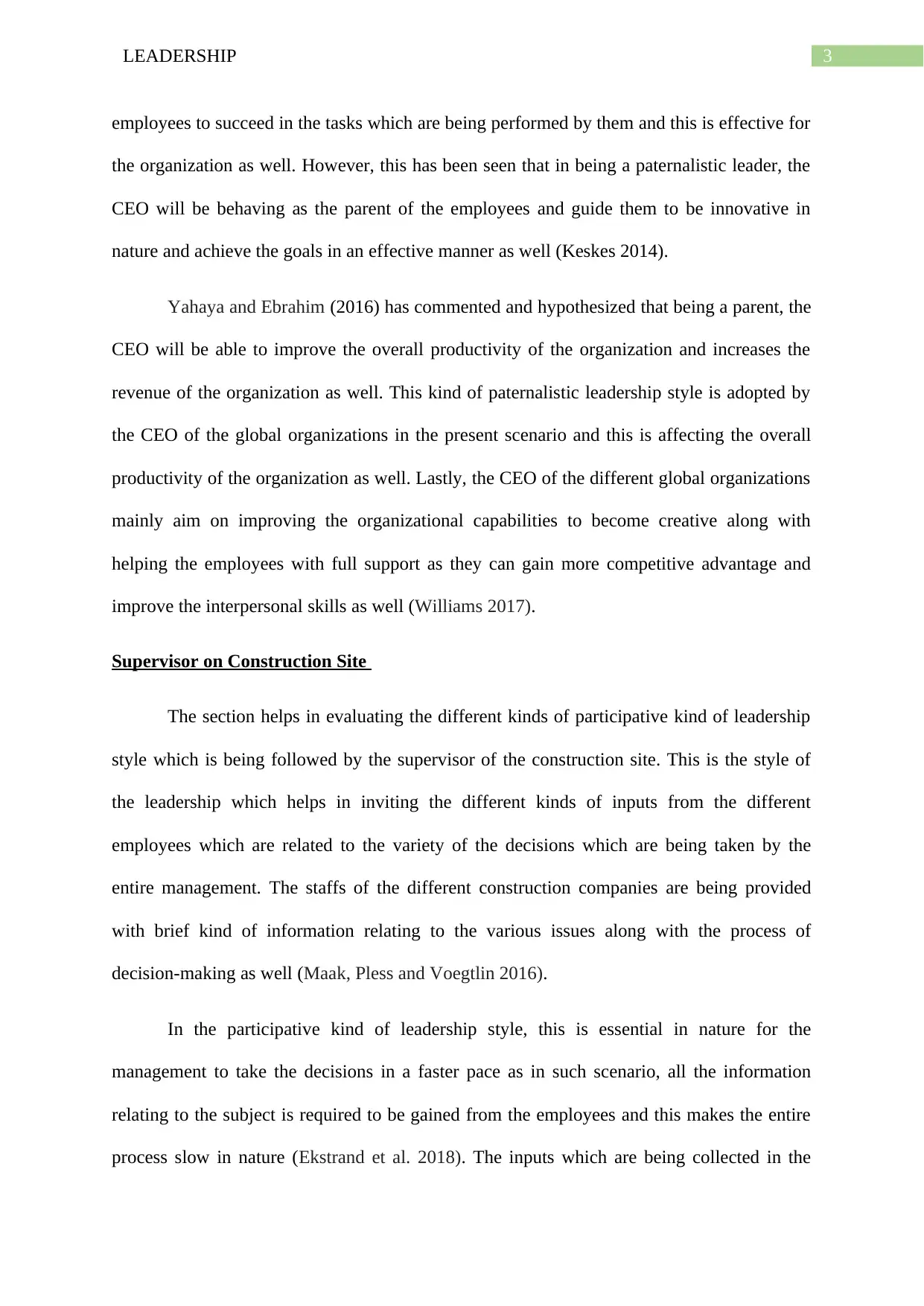
3LEADERSHIP
employees to succeed in the tasks which are being performed by them and this is effective for
the organization as well. However, this has been seen that in being a paternalistic leader, the
CEO will be behaving as the parent of the employees and guide them to be innovative in
nature and achieve the goals in an effective manner as well (Keskes 2014).
Yahaya and Ebrahim (2016) has commented and hypothesized that being a parent, the
CEO will be able to improve the overall productivity of the organization and increases the
revenue of the organization as well. This kind of paternalistic leadership style is adopted by
the CEO of the global organizations in the present scenario and this is affecting the overall
productivity of the organization as well. Lastly, the CEO of the different global organizations
mainly aim on improving the organizational capabilities to become creative along with
helping the employees with full support as they can gain more competitive advantage and
improve the interpersonal skills as well (Williams 2017).
Supervisor on Construction Site
The section helps in evaluating the different kinds of participative kind of leadership
style which is being followed by the supervisor of the construction site. This is the style of
the leadership which helps in inviting the different kinds of inputs from the different
employees which are related to the variety of the decisions which are being taken by the
entire management. The staffs of the different construction companies are being provided
with brief kind of information relating to the various issues along with the process of
decision-making as well (Maak, Pless and Voegtlin 2016).
In the participative kind of leadership style, this is essential in nature for the
management to take the decisions in a faster pace as in such scenario, all the information
relating to the subject is required to be gained from the employees and this makes the entire
process slow in nature (Ekstrand et al. 2018). The inputs which are being collected in the
employees to succeed in the tasks which are being performed by them and this is effective for
the organization as well. However, this has been seen that in being a paternalistic leader, the
CEO will be behaving as the parent of the employees and guide them to be innovative in
nature and achieve the goals in an effective manner as well (Keskes 2014).
Yahaya and Ebrahim (2016) has commented and hypothesized that being a parent, the
CEO will be able to improve the overall productivity of the organization and increases the
revenue of the organization as well. This kind of paternalistic leadership style is adopted by
the CEO of the global organizations in the present scenario and this is affecting the overall
productivity of the organization as well. Lastly, the CEO of the different global organizations
mainly aim on improving the organizational capabilities to become creative along with
helping the employees with full support as they can gain more competitive advantage and
improve the interpersonal skills as well (Williams 2017).
Supervisor on Construction Site
The section helps in evaluating the different kinds of participative kind of leadership
style which is being followed by the supervisor of the construction site. This is the style of
the leadership which helps in inviting the different kinds of inputs from the different
employees which are related to the variety of the decisions which are being taken by the
entire management. The staffs of the different construction companies are being provided
with brief kind of information relating to the various issues along with the process of
decision-making as well (Maak, Pless and Voegtlin 2016).
In the participative kind of leadership style, this is essential in nature for the
management to take the decisions in a faster pace as in such scenario, all the information
relating to the subject is required to be gained from the employees and this makes the entire
process slow in nature (Ekstrand et al. 2018). The inputs which are being collected in the
Paraphrase This Document
Need a fresh take? Get an instant paraphrase of this document with our AI Paraphraser
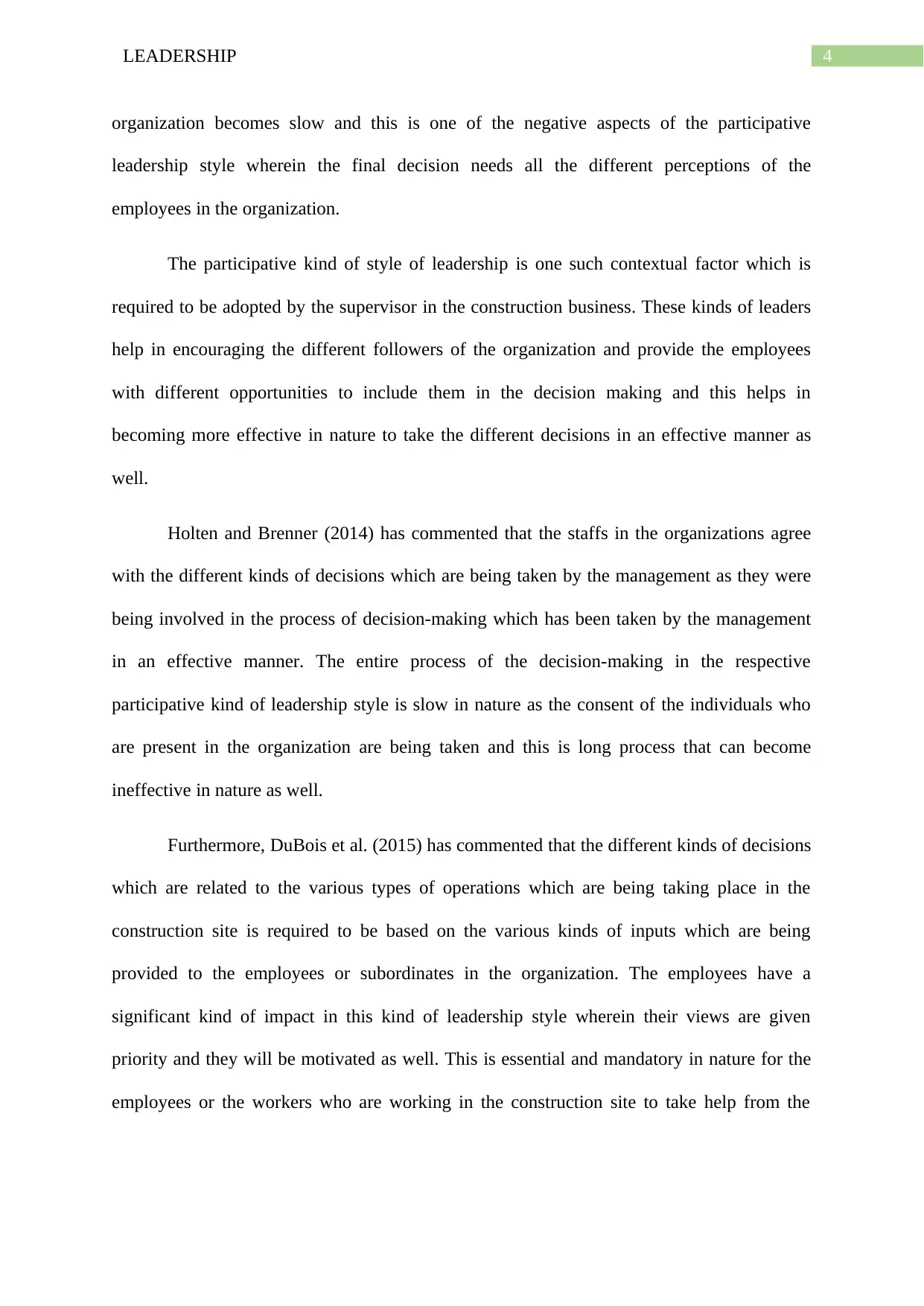
4LEADERSHIP
organization becomes slow and this is one of the negative aspects of the participative
leadership style wherein the final decision needs all the different perceptions of the
employees in the organization.
The participative kind of style of leadership is one such contextual factor which is
required to be adopted by the supervisor in the construction business. These kinds of leaders
help in encouraging the different followers of the organization and provide the employees
with different opportunities to include them in the decision making and this helps in
becoming more effective in nature to take the different decisions in an effective manner as
well.
Holten and Brenner (2014) has commented that the staffs in the organizations agree
with the different kinds of decisions which are being taken by the management as they were
being involved in the process of decision-making which has been taken by the management
in an effective manner. The entire process of the decision-making in the respective
participative kind of leadership style is slow in nature as the consent of the individuals who
are present in the organization are being taken and this is long process that can become
ineffective in nature as well.
Furthermore, DuBois et al. (2015) has commented that the different kinds of decisions
which are related to the various types of operations which are being taking place in the
construction site is required to be based on the various kinds of inputs which are being
provided to the employees or subordinates in the organization. The employees have a
significant kind of impact in this kind of leadership style wherein their views are given
priority and they will be motivated as well. This is essential and mandatory in nature for the
employees or the workers who are working in the construction site to take help from the
organization becomes slow and this is one of the negative aspects of the participative
leadership style wherein the final decision needs all the different perceptions of the
employees in the organization.
The participative kind of style of leadership is one such contextual factor which is
required to be adopted by the supervisor in the construction business. These kinds of leaders
help in encouraging the different followers of the organization and provide the employees
with different opportunities to include them in the decision making and this helps in
becoming more effective in nature to take the different decisions in an effective manner as
well.
Holten and Brenner (2014) has commented that the staffs in the organizations agree
with the different kinds of decisions which are being taken by the management as they were
being involved in the process of decision-making which has been taken by the management
in an effective manner. The entire process of the decision-making in the respective
participative kind of leadership style is slow in nature as the consent of the individuals who
are present in the organization are being taken and this is long process that can become
ineffective in nature as well.
Furthermore, DuBois et al. (2015) has commented that the different kinds of decisions
which are related to the various types of operations which are being taking place in the
construction site is required to be based on the various kinds of inputs which are being
provided to the employees or subordinates in the organization. The employees have a
significant kind of impact in this kind of leadership style wherein their views are given
priority and they will be motivated as well. This is essential and mandatory in nature for the
employees or the workers who are working in the construction site to take help from the
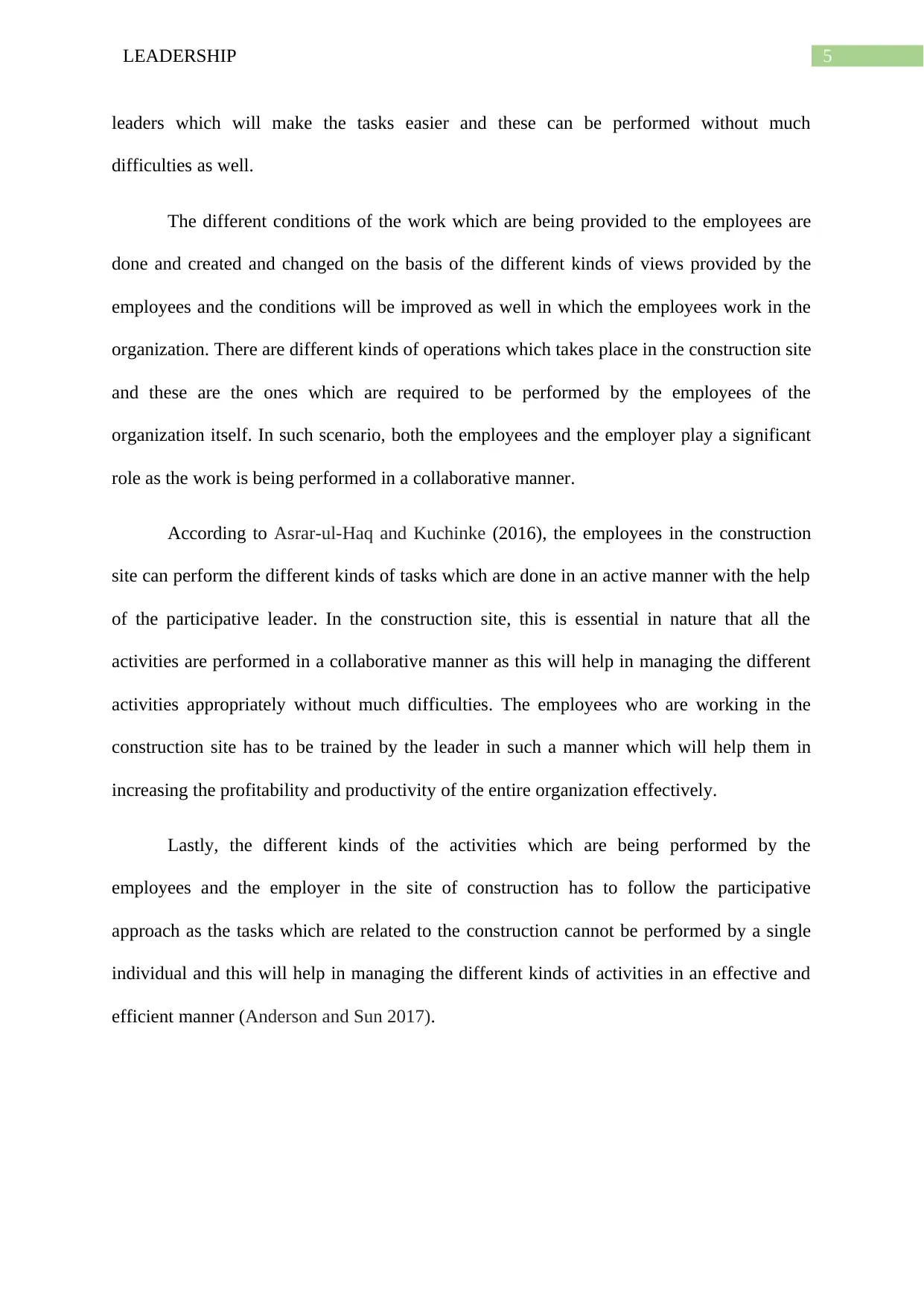
5LEADERSHIP
leaders which will make the tasks easier and these can be performed without much
difficulties as well.
The different conditions of the work which are being provided to the employees are
done and created and changed on the basis of the different kinds of views provided by the
employees and the conditions will be improved as well in which the employees work in the
organization. There are different kinds of operations which takes place in the construction site
and these are the ones which are required to be performed by the employees of the
organization itself. In such scenario, both the employees and the employer play a significant
role as the work is being performed in a collaborative manner.
According to Asrar-ul-Haq and Kuchinke (2016), the employees in the construction
site can perform the different kinds of tasks which are done in an active manner with the help
of the participative leader. In the construction site, this is essential in nature that all the
activities are performed in a collaborative manner as this will help in managing the different
activities appropriately without much difficulties. The employees who are working in the
construction site has to be trained by the leader in such a manner which will help them in
increasing the profitability and productivity of the entire organization effectively.
Lastly, the different kinds of the activities which are being performed by the
employees and the employer in the site of construction has to follow the participative
approach as the tasks which are related to the construction cannot be performed by a single
individual and this will help in managing the different kinds of activities in an effective and
efficient manner (Anderson and Sun 2017).
leaders which will make the tasks easier and these can be performed without much
difficulties as well.
The different conditions of the work which are being provided to the employees are
done and created and changed on the basis of the different kinds of views provided by the
employees and the conditions will be improved as well in which the employees work in the
organization. There are different kinds of operations which takes place in the construction site
and these are the ones which are required to be performed by the employees of the
organization itself. In such scenario, both the employees and the employer play a significant
role as the work is being performed in a collaborative manner.
According to Asrar-ul-Haq and Kuchinke (2016), the employees in the construction
site can perform the different kinds of tasks which are done in an active manner with the help
of the participative leader. In the construction site, this is essential in nature that all the
activities are performed in a collaborative manner as this will help in managing the different
activities appropriately without much difficulties. The employees who are working in the
construction site has to be trained by the leader in such a manner which will help them in
increasing the profitability and productivity of the entire organization effectively.
Lastly, the different kinds of the activities which are being performed by the
employees and the employer in the site of construction has to follow the participative
approach as the tasks which are related to the construction cannot be performed by a single
individual and this will help in managing the different kinds of activities in an effective and
efficient manner (Anderson and Sun 2017).
⊘ This is a preview!⊘
Do you want full access?
Subscribe today to unlock all pages.

Trusted by 1+ million students worldwide
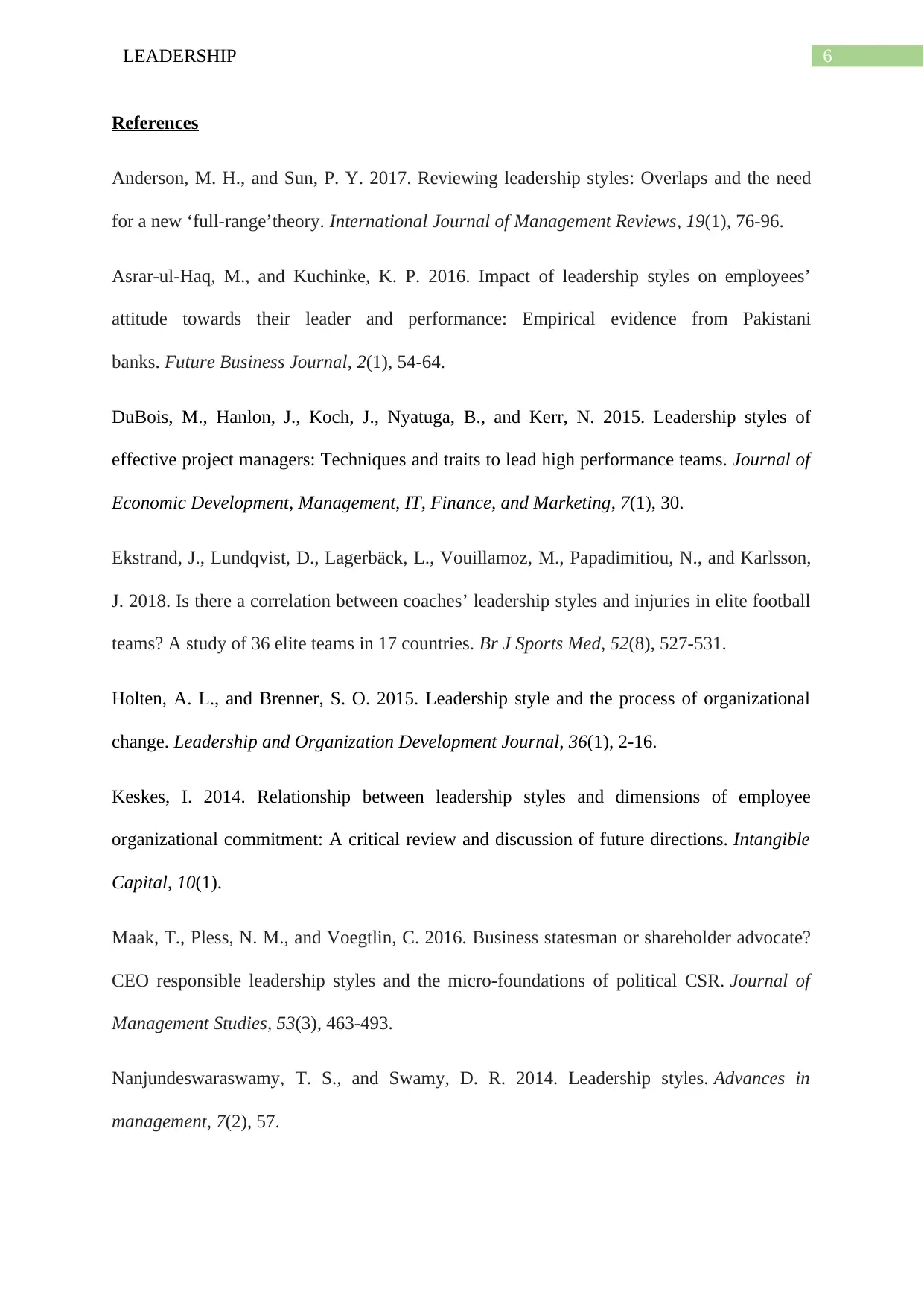
6LEADERSHIP
References
Anderson, M. H., and Sun, P. Y. 2017. Reviewing leadership styles: Overlaps and the need
for a new ‘full‐range’theory. International Journal of Management Reviews, 19(1), 76-96.
Asrar-ul-Haq, M., and Kuchinke, K. P. 2016. Impact of leadership styles on employees’
attitude towards their leader and performance: Empirical evidence from Pakistani
banks. Future Business Journal, 2(1), 54-64.
DuBois, M., Hanlon, J., Koch, J., Nyatuga, B., and Kerr, N. 2015. Leadership styles of
effective project managers: Techniques and traits to lead high performance teams. Journal of
Economic Development, Management, IT, Finance, and Marketing, 7(1), 30.
Ekstrand, J., Lundqvist, D., Lagerbäck, L., Vouillamoz, M., Papadimitiou, N., and Karlsson,
J. 2018. Is there a correlation between coaches’ leadership styles and injuries in elite football
teams? A study of 36 elite teams in 17 countries. Br J Sports Med, 52(8), 527-531.
Holten, A. L., and Brenner, S. O. 2015. Leadership style and the process of organizational
change. Leadership and Organization Development Journal, 36(1), 2-16.
Keskes, I. 2014. Relationship between leadership styles and dimensions of employee
organizational commitment: A critical review and discussion of future directions. Intangible
Capital, 10(1).
Maak, T., Pless, N. M., and Voegtlin, C. 2016. Business statesman or shareholder advocate?
CEO responsible leadership styles and the micro‐foundations of political CSR. Journal of
Management Studies, 53(3), 463-493.
Nanjundeswaraswamy, T. S., and Swamy, D. R. 2014. Leadership styles. Advances in
management, 7(2), 57.
References
Anderson, M. H., and Sun, P. Y. 2017. Reviewing leadership styles: Overlaps and the need
for a new ‘full‐range’theory. International Journal of Management Reviews, 19(1), 76-96.
Asrar-ul-Haq, M., and Kuchinke, K. P. 2016. Impact of leadership styles on employees’
attitude towards their leader and performance: Empirical evidence from Pakistani
banks. Future Business Journal, 2(1), 54-64.
DuBois, M., Hanlon, J., Koch, J., Nyatuga, B., and Kerr, N. 2015. Leadership styles of
effective project managers: Techniques and traits to lead high performance teams. Journal of
Economic Development, Management, IT, Finance, and Marketing, 7(1), 30.
Ekstrand, J., Lundqvist, D., Lagerbäck, L., Vouillamoz, M., Papadimitiou, N., and Karlsson,
J. 2018. Is there a correlation between coaches’ leadership styles and injuries in elite football
teams? A study of 36 elite teams in 17 countries. Br J Sports Med, 52(8), 527-531.
Holten, A. L., and Brenner, S. O. 2015. Leadership style and the process of organizational
change. Leadership and Organization Development Journal, 36(1), 2-16.
Keskes, I. 2014. Relationship between leadership styles and dimensions of employee
organizational commitment: A critical review and discussion of future directions. Intangible
Capital, 10(1).
Maak, T., Pless, N. M., and Voegtlin, C. 2016. Business statesman or shareholder advocate?
CEO responsible leadership styles and the micro‐foundations of political CSR. Journal of
Management Studies, 53(3), 463-493.
Nanjundeswaraswamy, T. S., and Swamy, D. R. 2014. Leadership styles. Advances in
management, 7(2), 57.
Paraphrase This Document
Need a fresh take? Get an instant paraphrase of this document with our AI Paraphraser
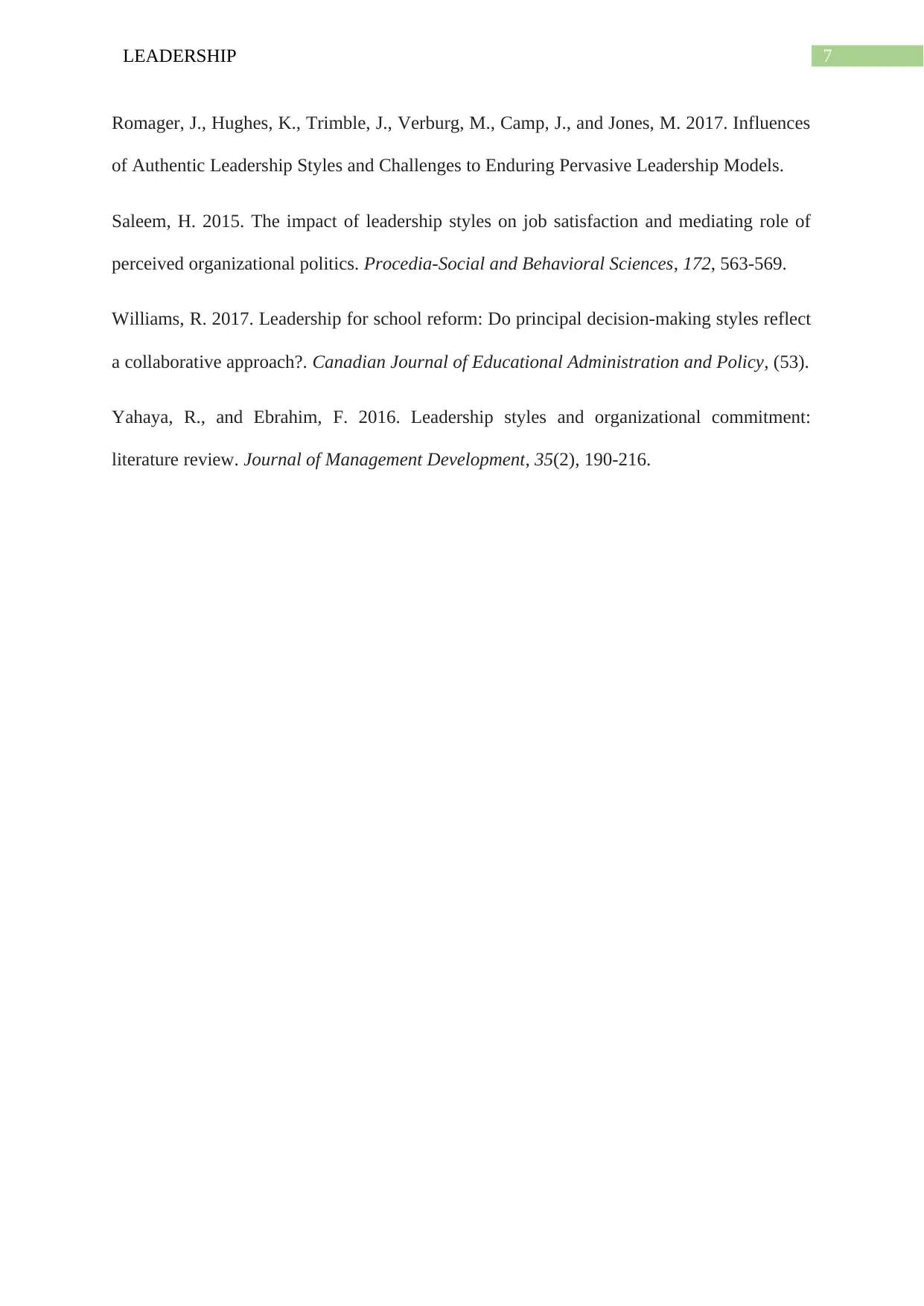
7LEADERSHIP
Romager, J., Hughes, K., Trimble, J., Verburg, M., Camp, J., and Jones, M. 2017. Influences
of Authentic Leadership Styles and Challenges to Enduring Pervasive Leadership Models.
Saleem, H. 2015. The impact of leadership styles on job satisfaction and mediating role of
perceived organizational politics. Procedia-Social and Behavioral Sciences, 172, 563-569.
Williams, R. 2017. Leadership for school reform: Do principal decision-making styles reflect
a collaborative approach?. Canadian Journal of Educational Administration and Policy, (53).
Yahaya, R., and Ebrahim, F. 2016. Leadership styles and organizational commitment:
literature review. Journal of Management Development, 35(2), 190-216.
Romager, J., Hughes, K., Trimble, J., Verburg, M., Camp, J., and Jones, M. 2017. Influences
of Authentic Leadership Styles and Challenges to Enduring Pervasive Leadership Models.
Saleem, H. 2015. The impact of leadership styles on job satisfaction and mediating role of
perceived organizational politics. Procedia-Social and Behavioral Sciences, 172, 563-569.
Williams, R. 2017. Leadership for school reform: Do principal decision-making styles reflect
a collaborative approach?. Canadian Journal of Educational Administration and Policy, (53).
Yahaya, R., and Ebrahim, F. 2016. Leadership styles and organizational commitment:
literature review. Journal of Management Development, 35(2), 190-216.
1 out of 8
Related Documents
Your All-in-One AI-Powered Toolkit for Academic Success.
+13062052269
info@desklib.com
Available 24*7 on WhatsApp / Email
![[object Object]](/_next/static/media/star-bottom.7253800d.svg)
Unlock your academic potential
Copyright © 2020–2025 A2Z Services. All Rights Reserved. Developed and managed by ZUCOL.





